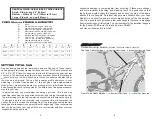
To get the correct pressure in your shock it is important to follow some guide-
lines. Thread the pump’s connector onto the Schraeder valve on the shock.
Pump to the desired pressure. Quickly unthread the connector from the
Schraeder valve until the connector breaks free. The pressure you have in
your shock is the one you pumped to. At this point do not re-attach the pump
to check your setting, as it will be inaccurate. This is due to some of the
shock’s air rushing into the pump’s hose, making the reading wildly incor-
rect.
HOW TO CORRECTLY PUMP YOUR SHOCK
Bottom Bracket Width: 68mm shell
Bottom Bracket Axle Length: determined by crank choice
Seat Post Diameter: 31.6mm
Head Tube Diameter: Top 1 1/8” 44mm Z.S headset only
: Bottom 1.5” 49.6mm headset only
Fork Type/Length: Shaver was designed around, and works
best with a 5” or 6” single crown fork. NO DUAL CROWN FORKS!
Use of Dual Crown Forks on the Shaver will void all warranties!
Front Derailleur: 34.9mm Top Pull
Rear Hub Spacing: 142mm x 12mm Thru Axle Hub
Disc Brake: The Shaver accepts a standard 6” I.S. rear caliper
mounted on the swingarm. Use of larger rotors requires the appropri
ate manufacturer-sized caliper adapter.
The Foes Shaver is a full suspension bicycle! It has 5.75” of rear travel, and
was designed as an aggressive trail bicycle. The Foes Shaver is not, by any
means, a freeride, jumping, or stunt riding frame. It is made for trail rides that,
at one point or another, require the full amount of travel of the shock. The
Shaver was made for riders who want to take advantage of longer wheel
travel, yet want the lightness for long climbs. This is the reason it is designed
around a single crown fork. Therefore, a single-crown fork between 140 and
160 mm works well with this frame.
If you bottom out your shock on a regular basis, you are undersprung or have
too little air pressure in your shock, and will damage your frame and shock.
Bottoming your shock on a consistent basis is considered by Foes to be
improper care of your bicycle frame and shock, and will void the warranty for
both, and all other warranties. If you bottom your shock consistently,
STOP!… and first check to make certain you have proper air pressure in your
shock. (It is vitally important to check the air pressure on the FOX
FloatAIR Shock EVERY TIME YOU RIDE.) If you have proper air pressure,
then your shock is either undersprung, or it has a problem. At this point it is
extremely important to not ride the bicycle, and make plans to get the shock
to a Foes technician to have it checked out and/or sprung correctly.
GENERAL SETUP
CAUTION! YOU WILL DAMAGE YOUR FRAME AND SHOCK IF YOU DO
NOT CORRECTLY SET UP AND MAINTAIN YOUR REAR SHOCK AND
SUSPENSION.
SHOCK AIR PRESSURE WARNING
FOES SPECS FOR BUILDING
A WORD ABOUT FORK CHOICE
3
6
The Foes Shaver is equipped with a replaceable derailleur hanger. This part
is installed as a safety feature, as well as a convenience to you, the owner. It
is not uncommon for foreign objects, such as sticks, stones and other debris
to bend your hanger. A bent hanger can occur from shifting hard under load,
and/or transporting your bicycle. Foes derailleur hangers are designed to
bend and break! This inherent design actually keeps more
REPLACEABLE DERAILLEUR HANGERS
In addition to the minimum seat post insertion mark on most seat posts, you
must follow the following recommendations for seat post insertion: a 31.6mm
seat post must be inserted a minimum of 4” into the seat tube of the frame.
Anything less than this will not be covered under warranty.
MINIMUM - MAXIMUM SEAT POST INSERTION
1) Keep your bike clean. Riding a dirty bike will cause all of your bearings,
bushings, contact points, finish, shock shaft and seal head area, and every
other moving part to wear much faster than if they were cleaned regularly.
Keeping your bike clean will also give you that satisfied feeling of taking care
of your investment in a high quality hand-crafted frame. Foes recommends
first rinsing loose dust and mud with hose water, taking care not to blast
water into areas that water could damage over time by lack of evaporation
quickly, like, pivots, bushings, bearings and shock parts, as well as the com-
ponents installed on your frame, like bottom brackets, head sets, gear sets
and the like. Wash the bicycle with a mild dilution of detergent and a soft
cloth. Rinse again, taking care not to force water into those areas mentioned.
Dry with a towel. A light coating of a light lubricant, like WD-40, can help
displace water from areas that are hard to reach. However, it is important to
note that these light lubricants can actually wash away oil and grease used
to lubricate the bicycle, and render brakes inoperable. If you use a light lubri-
cant, use it only to displace water, and keep it away from brake pads and
rotors.
2) Keep your bike lubricated. After cleaning your bike, lubricate your chain
and drive train with an appropriate lube.
3) Periodically check all of the bolts and fasteners on your bike. Do not over-
tighten anything, as this too will void your warranties – just check and “snug”
each fastener. Also, it is a good idea to check all of your frame’s welds and
tube junctions for cracks and any damage. Aluminum has a limited life –
inspect your frame in a well lit area, and inspect carefully – especially after
crashes.
4) Keep the shock shaft, and surrounding areas, clean of dirt, debris and crud
– wipe it off after every ride.
GOOD RIDER BICYCLE MAINTENANCE
























